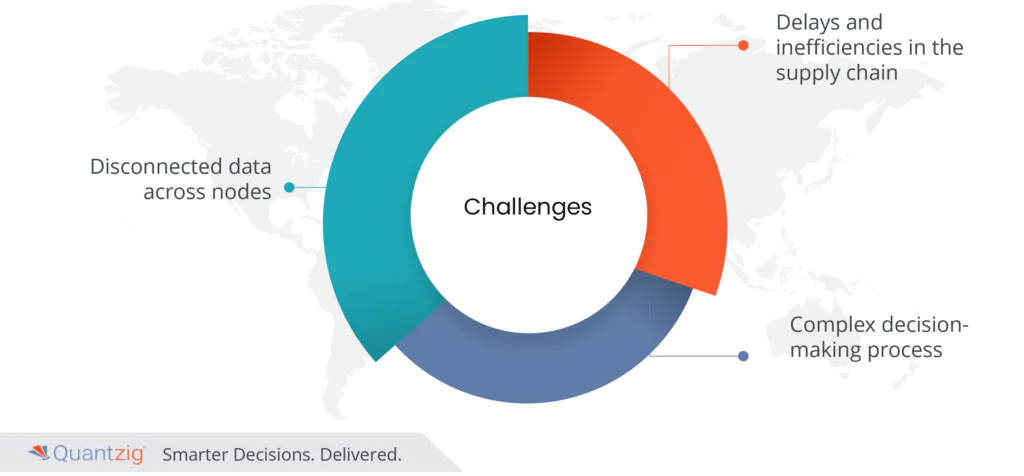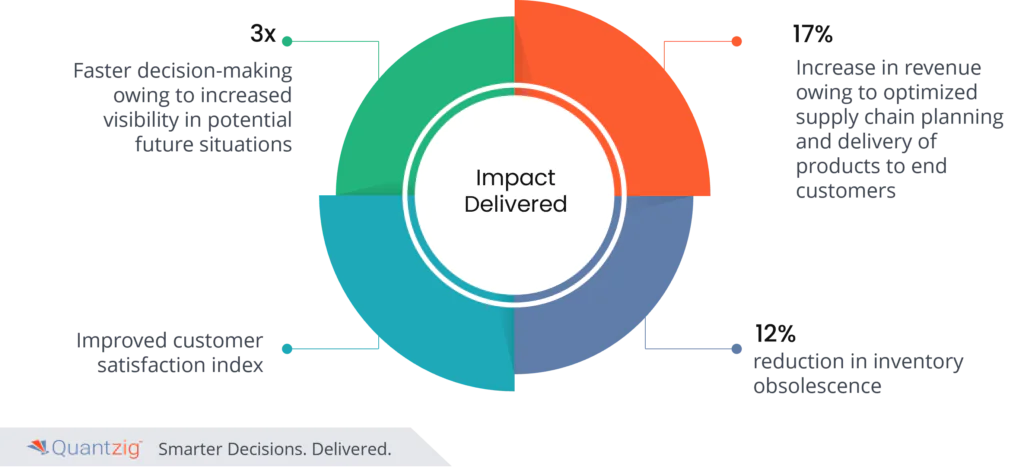Written By: Sudeshna Ghosh
Table of Contents
Introduction
In the ever-changing landscape of healthcare, the convergence of technology and supply chain management emerges as a critical arena for transformation. In this era of unprecedented challenges and opportunities, leveraging healthcare supply chain analytics becomes crucial for driving innovation in healthcare delivery. This article explores the dynamic space where data-driven insights and strategic logistics intersect to elevate patient care, optimize resource allocation, and mitigate rising costs. Come along as we navigate through the corridors of healthcare innovation, where the influence of healthcare supply chain analytics is poised to revolutionize how we heal and serve our communities.
This journey into healthcare innovation spotlights the vital role of Healthcare Supply Chain Analytics. Amidst patient demographic shifts and drug shortages, understanding market players and evolving business models becomes paramount. Utilizing analytics tools to streamline supply chain processes within pharma and healthcare organizations is essential, particularly in addressing drug and medical supply shortages. Effective hospital supply chain management is crucial for managing procurement costs and ensuring supply chain efficiency.
Looking towards the future, the landscape is shaped by digital transformation and the rise of digital supply networks. Healthcare supply chain analytics software plays a pivotal role in optimizing operations, while data visualization and advanced analytics provide actionable insights. Healthcare Supply Chain Leaders rely on diagnostic analytics and Key Performance Indicators (KPIs) to drive continuous improvement.
The integration of Cloud-Based Enterprise Resource Planning (ERP) Systems and machine learning further enhances supply chain capabilities. Together, these technologies enable healthcare organizations to adapt to changing demands and navigate complexities with agility. As we chart the course towards the future of healthcare supply chain, the power of analytics and innovation holds the promise of a more resilient and responsive healthcare system.
Book a demo to experience the meaningful insights we derive from data through our healthcare supply chain analytical tools and platform capabilities. Schedule a demo today!
Request a Free DemoImportance of Healthcare Innovation Through Supply Chain Analytics:
Ensuring that all the required elements, including Healthcare Supply Chain Analytics, Patient demographics, Drug shortages, Rising costs, Market players, Business models, Analytics tools, Supply chain processes, Pharma and healthcare organizations, Drug and medical supply shortages, Hospital supply chain management, Procurement costs, Digital supply networks, Future of healthcare supply chain, Digital transformation, Healthcare supply chain analytics software, Supply chain efficiency, Data Visualization, Advanced Analytics, Healthcare Supply Chain Leaders, Diagnostic Analytics, Cloud-Based Enterprise Resource Planning (ERP) Systems, Machine Learning, and Key Performance Indicators (KPIs), are available at the end consumption node with clinicians is paramount for delivering effective patient care. This process involves a delicate balance between inventory management and timely distribution. Any missing element can disrupt the entire care delivery chain, adversely affecting patient experience and outcomes.
Inventory excess poses a significant challenge, as overstocking can lead to obsolescence-related losses. Maintaining the right balance between supply and demand is therefore essential. It requires sophisticated supply chain analytics and management strategies to optimize the inventory levels while ensuring that the end care is delivered to the right stakeholders in the right quantity and at the right time.
How Can Healthcare Supply Chain Analytics Maximize Innovation in Healthcare?
In the landscape of healthcare innovation, leveraging advanced supply chain analytics presents unparalleled opportunities for optimization and improvement. By harnessing the power of predictive modeling and prescriptive analytics, healthcare organizations can proactively address fluctuations in demand and anticipate shifts in patient needs. Through the integration of IoT sensors and artificial intelligence, real-time data insights enable proactive monitoring of inventory optimization efforts and operational efficiency, fostering a culture of continuous improvement. Collaborative efforts between healthcare providers and patients are facilitated through BI dashboards and scorecards, promoting evidence-based decision-making and strategic sourcing initiatives.
The implementation of multienterprise work management and deep collaboration enhances granular visibility and resource utilization, mitigating supply chain disruptions and minimizing risk. By breaking down data and communication silos and fostering greater levels of collaboration, organizations can capitalize on optimization opportunities and drive financial impact. Furthermore, the utilization of supply chain analytics enables the identification of patterns and trends, empowering organizations to make informed decisions and maximize the potential of healthcare resources. Through strategic partnerships with entities like the AHRMM and Global Healthcare Exchange (GHX), healthcare organizations can leverage cutting-edge SCM solutions and logistics capabilities, ultimately maximizing innovation and driving transformative change in the healthcare landscape.
Challenges while implementing healthcare innovation through supply chain analytics:

- Disconnected data across nodes difficult to connect and identify insights:
Disconnected data across various nodes in a supply chain presents a substantial challenge in today’s complex healthcare landscape. When data is siloed and not seamlessly integrated, it becomes difficult to connect and extract valuable insights. This fragmentation hinders the ability to make informed decisions that optimize the supply chain.
- Multiple business stakeholders lead to complex decision-making processes often impacting the agility of the supply chain:
Furthermore, the involvement of multiple business stakeholders can exacerbate this issue. With various departments and teams having their data and decision-making processes, coordination becomes intricate. This complexity often leads to delays and inefficiencies in the supply chain, impacting its overall agility.
Experience the advantages firsthand by testing a customized complimentary pilot designed to address your specific healthcare analytical requirements. Pilot studies are non-committal in nature.
Request a Free PilotBenefits of healthcare innovation through supply chain analytics:
An agile supply chain, characterized by seamless coordination and optimal performance across its various nodes, yields a twofold benefit in healthcare. Firstly, it leads to higher profit margins by minimizing waste, reducing costs, and enhancing resource utilization. Secondly, it significantly improves the experiences of both patients and clinicians. Timely access to essential supplies ensures uninterrupted patient care, elevating the overall healthcare experience. For clinicians, streamlined operations enable them to focus on patient care rather than supply issues. In essence, an agile supply chain serves as a catalyst for financial success and enhanced healthcare delivery, fostering a win-win scenario for all stakeholders involved.
The integration of BI dashboards and scorecards facilitates evidence-based decisions and identifies optimization opportunities. Strategic sourcing initiatives are guided by insights into financial impact and the principles of a clinically integrated supply chain. Multienterprise work management streamlines processes and mitigates supplier incidents by breaking down data and communication silos. Enhanced workflows and the seamless sharing of information promote greater levels of collaboration and granular visibility.
Proactive detection and proactive monitoring leverage deep collaboration and performance data analysis to identify patterns and trends, allowing organizations to anticipate shifts in demand and optimize resource utilization. This proactive approach extends to risk mitigation through continuous improvement processes and robust supplier risk management strategies.
The integration of IoT sensors and artificial intelligence enables predictive modeling and empowers organizations to leverage digital networking technology for enhanced supply chain analytics. Healthcare systems harness the power of unstructured data through predictive analytics and prescriptive analytics to inform SCM solutions and drive data-driven data analysis. Organizations leverage platforms like AHRMM and Global Healthcare Exchange (GHX) for efficient consignment implant order automation and talent acquisition in logistics and demand planning.
As healthcare systems navigate supply chain disruptions, the integration of advanced technologies and data-driven strategies is essential to ensure resilience and agility in the face of challenges, ultimately optimizing healthcare delivery and patient outcomes.
Quantzig’s Success Story
Client Details:
A leading healthcare company located in the USA.
The challenges faced by the Client:
The client had disconnected data across nodes and frequently ended in scenarios of overstocking or understocking of inventory. This led to revenue leakage and reduced margins. Business leaders, however, were struggling to make the right decisions owing to a lack of visibility and identification of bottlenecks/inefficiencies in the supply chain network.
Solutions offered by Quantzig:
Quantzig collaborated with our team to develop a comprehensive digital twin of the entire global supply chain network. Leveraging Healthcare Supply Chain Analytics, Patient demographics, and insights into Drug shortages and Rising costs, we constructed a powerful tool for strategic planning. This digital twin enabled our client to simulate future scenarios, anticipating challenges such as Drug and medical supply shortages and mitigating risks associated with incremental costs.
Through Market players analysis and examination of Business models, our client gained valuable insights into optimizing Supply chain processes. By utilizing Analytics tools and Healthcare supply chain analytics software, they could visualize data effectively and make informed decisions. This approach empowered Hospital supply chain management to proactively address procurement costs and streamline operations.
The implementation of Digital supply networks and Cloud-Based Enterprise Resource Planning (ERP) Systems enhanced efficiency and facilitated Digital transformation within Pharma and healthcare organizations. Machine Learning algorithms and Advanced Analytics provided predictive capabilities, enabling Diagnostic Analytics for preemptive action.
Key Performance Indicators (KPIs) served as benchmarks for success, guiding the optimization of supply chain efficiency. Through Data Visualization, Healthcare Supply Chain Leaders could interpret complex data, driving continuous improvement initiatives. Ultimately, this collaboration led to a resilient future for the healthcare supply chain, characterized by proactive decision-making and sustainable outcomes.
Impact Delivered:

Through greater levels of collaboration and continuous improvement processes, our SCM Solutions have revolutionized the way we approach supply chain management. By leveraging advanced Data Analysis techniques and tapping into the collective Talent within our organization, we’ve achieved remarkable results.
Our SCM Solutions have facilitated 3x faster decision-making, owing to increased visibility in potential future situations. This enhanced foresight enables us to adapt swiftly to changing market conditions and customer demands, leading to an impressive 17% increase in revenue. Moreover, our optimized supply chain planning and delivery of products to end customers have significantly improved the customer satisfaction index.
Furthermore, our continuous improvement efforts have resulted in a remarkable 12% reduction in inventory obsolescence, demonstrating our commitment to efficiency and sustainability. By fostering collaboration across teams, analyzing patient demographics, and empowering our workforce with the right tools and expertise, we’ve unlocked new levels of success in supply chain management.
Discover how Quantzig’s expertise in supply chain analytics transformed our client’s healthcare operations, leading to improved patient care and cost efficiencies. Read the full case study now to unlock the secrets of healthcare innovation.
Get started with your complimentary trial today and delve into our platform without any obligations. Explore our wide range of customized, consumption driven analytical solutions services built across the analytical maturity levels.
Start your Free TrialConclusion
In the dynamic world of healthcare, the integration of Supply chain analytics emerges as a beacon of progress and possibility. The journey through this article has illuminated the transformative power of data-driven insights and strategic logistics in redefining patient care. It is evident that, in the pursuit of healthcare innovation, the role of supply chain analytics cannot be overstated. As we navigate the ever-evolving healthcare landscape, the imperative remains clear: harnessing the potential of supply chain analytics will not only revolutionize the way we deliver care but also usher in an era of heightened efficiency, improved outcomes, and ultimately a healthier world for all.
Incorporating IT (Information Technology) solutions can mitigate supply disruption and tackle supply chain issues, enhancing descriptive analytics capabilities. Leveraging technology in supply networks allows for better tracking processes and streamlines time-consuming tasks such as inventory management. Improving demand forecasting accuracy minimizes waste in hospital supply chains and optimizes overall margins, prioritizing patient safety while enhancing resilience and agility.
Insights from sources like the IDC Whitepaper shed light on the Pharma Supply Chain Struggle, addressing supply costs and mitigating uncertainty through robust demand and capacity planning. Efficient procurement cost management and ongoing inventory optimization efforts adapt to fluctuations in demand, guided by essential supply chain metrics and KPIs.
Prioritizing operational efficiency and maximizing supply utilization aligns with efforts to accurately forecast demand and identify standardization opportunities across healthcare providers. Through the integration of supply chain analytics and innovative solutions, healthcare systems can navigate challenges and seize opportunities to deliver optimal care while driving sustainable outcomes and make a bright future of healthcare supply chain.



